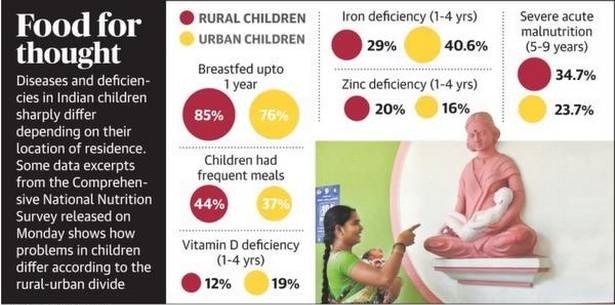Governance
National Nutrition Survey
- 09 Oct 2019
- 4 min read
The first-ever comprehensive National Nutrition Survey has been conducted by the Ministry of Health and Family Welfare and the United Nations Children Fund (UNICEF) to measure the level of malnutrition in India.
- The Comprehensive National Nutrition Survey is the largest micronutrient survey implemented globally to assess nutrient deficiency among children for the first time in India.
Key Findings
- Breastfeeding:
- 83% of children between 12 and 15 months continued to be breastfed in the country.
- A higher proportion of children (12-15 months) residing in rural areas are breastfed (85%) compared to children in urban areas (76%).
- Breastfeeding is inversely proportional to household wealth.
- The rural children receive meals more frequently (44%) as compared to 37% of urban children.
- Higher proportion of children residing in urban areas (26.9%) are fed an adequately diverse diet as compared to those in rural areas (19%).
- Iron Deficiency:
- Children and adolescents residing in urban areas have a higher (40.6%) prevalence of iron deficiency compared to their rural counterparts (29%) due to a better performance of the government’s health programmes in rural areas.
- Vitamin D Deficiency:
- Higher deficiency of Vitamin D in urban areas (19%) is observed compared to rural areas (12%). This is despite 74% of children living in cities consume dairy products as compared to 58% in rural areas.
- Zinc deficiency:
- The rural children lag in the intake of zinc which causes diarrhea, growth retardation, loss of appetite and impaired immune function.
- Among children aged 1-4 years, zinc deficiency is more common in rural areas (20%) compared to urban areas (16%).
- Obesity:
- 14.5% of children in the age group of 5 to 9 years in urban areas have higher Subscapular Skinfold Thickness (SSFT) than 5.3% in rural areas.
- Whereas 10.4% of adolescents surveyed in urban areas in the age group of 10-19 had higher SSFT than 4.3% in rural areas.
- Subscapular Skinfold Thickness (SSFT) measurement is a reliable, cheap, simple, noninvasive method of body fat estimation at all ages including the neonatal period.
- Stunting:
- Overall 35 % of Indian children aged 0-4 years were stunted.
- Rural areas witnesses a higher prevalence of stunting (37% ) versus 27% in urban areas.
- Bihar, Madhya Pradesh, Rajasthan, and Uttar Pradesh have a high (37-42 % ) stunting prevalence.
- The lowest prevalence of stunting (16-21 %) was found in Goa and Jammu and Kashmir.
- Severe Acute Malnutrition:
- 34.7% in rural areas for children in 5-9 years versus 23.7% in urban areas.
- 32.4%in rural areas for adolescents in 10-19 years versus 27.4% in urban areas.
- Considering the overall scenario the rural parts of the country face a higher percentage of children suffering from stunting, underweight and wasting compared to urban parts of the country.
- The survey also reveals that Indian children are facing the double burden of malnutrition and rising risk of non-communicable diseases including diabetes, high cholesterol, chronic kidney disease, and hypertension.







